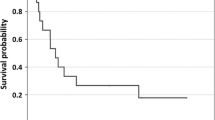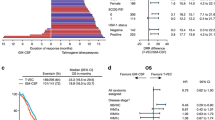Abstract
Purpose: We conducted a phase I trial of interleukin 2 (IL-2) in combination with chimeric 14.18 (ch14.18) and murine R24 antibodies to determine the maximal tolerated dose (MTD), immunological effects, and toxicity of this treatment combination. Experimental Design: Twenty-seven patients with either melanoma (23 patients) or sarcoma (4 patients) were enrolled to receive a combination therapy with ch14.18 and R24 antibodies together with continuous infusion of Roche IL-2 (1.5×106 U/m2/day, 26 patients) or Chiron IL-2 (4.5×106 U/m2/day, 1 patient) given 4 days/week for 3 weeks. The antibodies ch14.18 (2–7.5 mg/m2/day) and R24 (1–10 mg/m2/day) were scheduled to be administered for 5 days during the second week of IL-2 therapy. Results: When given in combination in this study, the MTD for ch14.18 was 5 mg/m2/day and the MTD for R24 was 5 mg/m2/day. Dose-limiting toxicities were severe allergic reactions to both ch14.18 and R24 as well as pain related to ch14.18. This ch14.18 MTD was lower than the 7.5 mg/m2/day MTD previously determined for ch14.18 given alone with the same dose and schedule of IL-2. Immunological effects included the induction of lymphokine-activated killer (LAK) activity and antibody-dependent cell-mediated cytoxicity (ADCC). Anti-idiotype response to ch14.18 was seen in six patients, including two melanoma patients who had a partial response to treatment. In addition to two partial responses, four patients had a stable disease and one patient remained without any evidence of disease. Conclusions: Immunotherapy with IL-2 in combination with ch14.18 and R24 antibodies augments LAK function and ADCC measured in vitro in all patients. While there exist theoretical advantages of combining these two antibodies, the MTD of ch14.18 and of R24 were lower than the MTD of each antibody in prior studies evaluating single antibody therapy with IL-2. As such, the combination of these two antibodies together with IL-2 therapy appeared to influence the MTD and toxicity of each of the administered antibodies.





Similar content being viewed by others
References
Albertini MR, Gan J, Jaeger P, Hank JA, Storer B, Schell K, Rivest T, Surfus J, Reisfeld RA, Schiller JH, Sondel PM (1996) Systemic interleukin-2 modulates the anti-idiotypic response to chimeric anti-GD2 antibody in patients with melanoma. J immunother 19:278–295
Albertini MR, Hank JA, Schiller JH, Khorsand M, Borchert AA, Gan J, Behhofer R, Storer B, Reisfeld RA, Sondel PM (1997) Phase IB trial of chimeric antidisialoganglioside antibody plus interleukin 2 for melanoma patients. Clin Cancer Res 3:1277–1288
Albertini MR, Hank JA, Sondel PM (1992) Strategies for improving antitumor activity utilizing IL-2: preclinical models and analysis of antitumor activity of lymphocytes from patients receiving IL-2. Biotherapy 4:189–198
Alpaugh RK, von Mehren M, Palazzo I, Atkins MB, Sparano JA, Schuchter L, Weiner LM, Dutcher JP (1998) Phase IB trial for malignant melanoma using R24 monoclonal antibody, interleukin-2/alpha-interferon. Med Onco1 15:191–198
Andersen MH, Gehl J, Reker S, Pedersen LO, Becker JC, Geertsen P, thor Straten P (2003) Dynamic changes of specific T cell responses to melanoma correlate with IL-2 administration. Semin Cancer Biol 13:449–459
Atkins MB, Lotze MT, Dutcher JP, Fisher RI, Weiss G, Margolin K, Abrams J, Sznol M, Parkinson D, Hawkins M, Paradise C, Kunkel L, Rosenberg SA (1999) High-dose recombinant interleukin 2 therapy for patients with metastatic melanoma: analysis of 270 patients treated between 1985 and 1993. J Clin Onco1 17:2105–2116
Bajorin DF, Chapman PB, Wong GY, Cody BV, Cordon-Cardo C, Dantes L, Templeton MA, Scheinberg D, Oettgen HF, Houghton AN (1992) Treatment with high dose mouse monoclonal (anti-GD3) antibody R24 in patients with metastatic melanoma. Melanoma Res 2:355–362
Bajorin DF, Chapman PB, Wong G, Coit DG, Kunicka J, Dimaggio J, Cordon-Cardo C, Umacher C, Dantes L, Templeton MA (1990) Phase I evaluation of a combination of monoclonal antibody R24 and interleukin-2 in patients with metastatic melanoma. Cancer Res 50:7490–7495
Barker E, Mueller BM, Handgretinger R, Herter M, Yu AL, Reisfeld RA (1992) Effect of a chimeric anti-ganglioside GD2 antibody on cell-mediated lysis of human neuroblastoma cells. Cancer Res 54:144–149
Bhattacharya-Chatterjee M, Chatterjee SK, Foon KA (2001) The anti-idiotype vaccines for immunotherapy. Curr Opin Mol Ther 3:63–69
Cheung NV, Guo H, Heller G, Cheung IY (2000) Induction of Ab3 and Ab3’ antibody was associated with long-term survival after anti-GD2 antibody therapy of stage 4 neuroblastoma. Clin Cancer Res 6:2653–2660
Dudley ME, Rosenberg SA (2003) Adoptive-cell-transfer therapy for the treatment of patients with cancer. Nature Rev Cancer 3:666–675
Frost JD, Hank JA, Reaman GH, Frierdich S, Seeger RC, Gan J, Anderson PM, Ettinger LJ, Cairo MS, Blazar BR, Krailo MD, Matthay KK, Reisfeld RA, Sondel PM (1997) A phase I/IB trial of murine monoclonal anti-GD2 antibody 14.G2a plus interleukin-2 in children with refractory neuroblastoma: a report of the Children’s Cancer Group. Cancer 80:317–333
Gan J, Kendra K, Ricci M, Hank JA, Gillies SD, Sondel PM (1999) Specific enzyme-linked immunosorbent assays for quantitation of antibody-cytokine fusion proteins. Clin Diagn Lab Immunol 6:236–242
Grimm EA, Mazumder A, Zhang HZ, Rosenberg SA (1982) The lymphokine-activated killer cell phenomenon. Lysis of natural killer-resistant fresh solid tumor cells by interleukin 2-activated autologous human peripheral blood lymphocytes. J Exp Med 155:1823–1841
Hank JA, Albertini MR, Schiller J, Sondel PM (1993) Activation of multiple effector mechanisms to enhance tumor immunotherapy. J immunother 14:329–335
Hank JA, Robinson RR, Surfus J, Mueller BM, Reisfeld RA, Cheung NK, Sondel PM (1990) Augmentation of antibody dependent cell mediated cytotoxicity following in vivo therapy with recombinant interleukin 2. Cancer Res 50:5234–5239
Hank JA, Surfus J, Gan J, Albertini MR, Lindstrom M, Schiller JH, Hotton KM, Khorsand M, Sondel PM (1999) Distinct clinical and laboratory activity of two recombinant interleukin-2 preparations. Clin Cancer Res 5:281–289
Hotton KM, Khorsand M, Hank JA, Albertini M, Kim KM, Wilding G, Salamat MS, Larson M, Sondel P, Schiller JH (2000) A phase Ib/II trial of granulocyte-macrophage-colony stimulating factor and interleukin-2 for renal cell carcinoma patients with pulmonary metastases: a case of fatal central nervous system thrombosis. Cancer 88:1892–1901
Kendra K, Gan J, Ricci M, Surfus J, Shaker A, Super M, Frost JD, Rakhmilevich A, Hank JA, Gillies SD, Sondel PM (1999) Pharmacokinetics and stability of the ch14.18-IL-2 fusion protein in mice. Cancer Immunol Immunother 48:219–229
Khazaeli MB, Conry RM, LoBuglio AF (1994) Human immune response to monoclonal antibodies. J Immunother 15:42–52
King DM, Albertini MR, Schalch H, Hank JA, Gan J, Surfus J, Mahvi D, Schiller JH, Warner T, Kim K, Eickhoff J, Kendra K, Reisfeld R, Gillies SD, Sondel P (2004) A phase I clinical trial of the immunocytokine EMD 273063 (hu14.18-IL2) in melanoma patients. J Clin Oncol 22:4463–4473
Kirkwood JM, Mascari RA, Edington HD, Rabkin MS, Day RS, Whiteside TL, Vlock DR, Shipe-Spotloe JM (2000) Analysis of therapeutic and immunologic effects of R24 anti-GD3 monoclonal antibody in 37 patients with metastatic melanoma. Cancer 88:2693–2702
Lode HN, Xiang R, Dreier T, Varki NM, Gillies SD, Reisfeld RA (1998) Natural killer cell-mediated eradication of neuroblastoma metastases to bone marrow by targeted interleukin-2 therapy. Blood 92:1706–1715
Lotze MT, Grimm EA, Mazumder A, Strausser JL, Rosenberg SA (1981) Lysis of fresh and cultured autologous tumor by lymphocytes cultured in T cell growth factor. Cancer Res 41:4420–4425
Mueller BM, Romerdahl CA, Gillies SD, Reisfeld RA (1990) Enhancement of antibody-dependent cytotoxicity with a chimeric anti-GD2 antibody. J Immunol 144:1382–1386
Nirmala R, Narayanan PR (2002) Flow cytometry—a rapid tool to correlate functional activities of human peripheral blood lymphocytes with their corresponding phenotypes after in vitro stimulation. BMC Immunol 3: p 9
Pross HF, Maroun JA (1984) The standardization of NK cell assays for use in studies of biological response modifiers. J Immunol Methods 68:235–249
Rakhmilevich AL, Timmins JG, Janssen K, Pohlmann EL, Sheehy MJ, Yang NS (1999) Gene gun-mediated IL-12 gene therapy induces antitumor effects in the absence of toxicity: a direct comparison with systemic IL-12 protein therapy. J Immunother 22:135–144
Rosenberg SA, Mule JJ, Speiss PJ, Reichert CM, Schwarz SL (1985) Regression of established pulmonary metastases and subcutaneous tumor mediated by the systemic administration of high-dose recombinant interleukin 2. J Exp Med 161:1169–1188
Rosenberg SA, Yang JC, Topalian SL, Schwartzentruber DJ, Weber JS, Parkinson DR, Seipp CA, Einhorn JH, White DE (1994) Treatment of 283 consecutive patients with metastatic melanoma or renal cell cancer using high-dose bolus interleukin 2. JAMA 271:907–913
Saleh MN, Khazaeli MB, Wheeler RH, Allen L, Tilden AB, Grizzle W, Reisfeld RA, Yu AL, Gilles SD, LoBuglio AF (1992) Phase I trial of the chimeric anti-GD2 monoclonal antibody ch14.18 in patients with malignant melanoma. Hum Antib Hybrid 3:19–24
Shi FS, Weber S, Gan J, Rakhmilevich AL, Mahvi DM (1999) GM-CSF secreted by cDNA-transfected tumor cells induces a more potent antitumor response than exogenous GM-CSF. Cancer Gene Ther 6:81–88
Soiffer RJ, Chapman PB, Murray C, Williams L, Unger P, Collins H, Houghton AN, Ritz J (1997) Administration of R24 monoclonal antibody and low-dose interleukin 2 for malignant melanoma. Clin Cancer Res 3:17–24
Sondel PM, Hank JA, Gan J, Neal Z, Albertini MR (2003) Preclinical and clinical development of immunocytokines. Curr Opin Investig Drugs 4:696–700
Sosman JA, Kohler PC, Hank JA, Moore KH, Bechhofer R, Storer B, Sondel PM (1988) Repetitive weekly cycles of IL-2. II. Clinical and immunologic effects of dose, schedule, and addition of indomethacin. J Natl Cancer Inst 80:1451–1460
Vadhan-Raj S, Cordon-Cardo C, Carswell E, Mintzer D, Dantis L, Duteau C, Templeton MA, Oettgen HF, Old LJ, Houghton AN (1988) Phase I trial of a mouse monoclonal antibody against GD3 ganglioside in patients with melanoma: induction of inflammatory responses at tumor sites. J Clin Oncol 6:1639–1648
Zhang S, Cordon-Cardo C, Zhang HS, Reuter VE, Adluri S, Hamilton WB, Lloyd KO, Livingston PO (1997) Selection of tumor antigens as targets for immune attack using immunohistochemistry: I. Focus on gangliosides. Int J Cancer 73:42–49
Acknowledgements
The authors thank the University of Wisconsin General Clinical Research Center (M01 RR03186), the Steve Leuthold Family Foundation (Jay Van Sloan Memorial) and Kathy Eagle (Tim Eagle Memorial) for gifts to the University of Wisconsin Comprehensive Cancer Center supporting our research on melanoma immunotherapy. The authors thank Brad Javorsky and Jean Surfus for technical assistance and Gloria St. Cyr for assistance with manuscript preparation.
Author information
Authors and Affiliations
Corresponding author
Additional information
This work is supported by NIH grants M01-RR03186, R01-CA32685, and P30-CA14520
Rights and permissions
About this article
Cite this article
Choi, B.S., Sondel, P.M., Hank, J.A. et al. Phase I trial of combined treatment with ch14.18 and R24 monoclonal antibodies and interleukin-2 for patients with melanoma or sarcoma. Cancer Immunol Immunother 55, 761–774 (2006). https://doi.org/10.1007/s00262-005-0069-7
Received:
Accepted:
Published:
Issue Date:
DOI: https://doi.org/10.1007/s00262-005-0069-7




